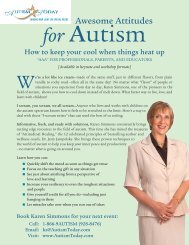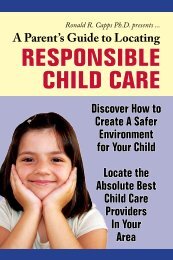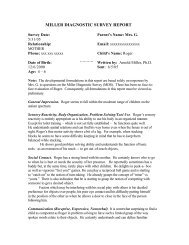Advice For Parents Of Young Autistic Children - Autism Today
Advice For Parents Of Young Autistic Children - Autism Today
Advice For Parents Of Young Autistic Children - Autism Today
You also want an ePaper? Increase the reach of your titles
YUMPU automatically turns print PDFs into web optimized ePapers that Google loves.
<strong>Parents</strong>, siblings, and friends may play an important role in assisting the development of children with autism.<br />
Typical pre-school children learn primarily by play, and the importance of play in teaching language and social<br />
skills cannot be overemphasized. Ideally, many of the techniques used in ABA, sensory integration, and other<br />
therapies can be extended throughout the day by family and friends.<br />
Applied Behavior Analysis: Many different behavioral interventions have been developed for children with<br />
autism, and they mostly fall under the category of Applied Behavioral Analysis (ABA). This approach generally<br />
involves therapists who work intensely, one-on-one with a child for 20 to 40 hours/week. <strong>Children</strong> are taught skills<br />
in a simple step-by-step manner, such as teaching colors one at a time. The sessions usually begin with formal,<br />
structured drills, such as learning to point to a color when its name is given; and then, after some time, there is a<br />
shift towards generalizing skills to other situations and environments.<br />
A study published by Dr. Ivar Lovaas at UCLA in 1987 involved two years of intensive, 40-hour/week<br />
behavioral intervention by trained graduate students working with 19 young autistic children ranging from 35 to 41<br />
months of age. Almost half of the children improved so much that they were indistinguishable from typical<br />
children, and these children went on to lead fairly normal lives. <strong>Of</strong> the other half, most had significant<br />
improvements, but a few did not improve much.<br />
ABA programs are most effective when started early, (before age 5 years), but they can also be helpful to<br />
older children. They are especially effective in teaching non-verbal children how to talk.<br />
There is general agreement that:<br />
• behavioral interventions involving one-on-one interactions are usually beneficial, sometimes with very<br />
positive results<br />
• the interventions are most beneficial with the youngest children, but older children can benefit<br />
• the interventions should involve a substantial amount of time each week, between 20-40 hours depending<br />
on whether the child is in school<br />
• prompting as much as necessary to achieve a high level of success, with a gradual fading of prompts<br />
• proper training of therapists and ongoing supervision<br />
• regular team meetings to maintain consistency between therapists and check for problems<br />
• most importantly, keeping the sessions fun for the children is necessary to maintain their interest and<br />
motivation<br />
<strong>Parents</strong> are encouraged to obtain training in ABA, so that they provide it themselves and possibly hire other people<br />
to assist. Qualified behavior consultants are often available, and there are often workshops on how to provide ABA<br />
therapy.<br />
Sensory Integration: Many autistic individuals have sensory problems, which can range from mild to severe.<br />
These problems involve either hypersensitivity or hyposensitivity to stimulation. Sensory integration focuses<br />
primarily on three senses — vestibular (i.e., motion, balance), tactile (i.e., touch), and proprioception (e.g., joints,<br />
ligaments). Many techniques are used to stimulate these senses in order to normalize them.<br />
Speech Therapy: This may be beneficial to many autistic children, but often only 1-2 hours/week is available, so it<br />
probably has only modest benefit unless integrated with other home and school programs. As mentioned earlier,<br />
sign language and PECS may also be very helpful in developing speech. Speech therapists should work on helping<br />
the child to hear hard consonant sounds such as the “c” in cup. It is often helpful if the therapist stretches out and<br />
enunciates the consonant sounds.<br />
Occupational Therapy: Can be beneficial for the sensory needs of these children, who often have hypo and/or<br />
hyper sensitivities to sound, sight, smell, touch, and taste. May include sensory integration (above).<br />
Physical Therapy: <strong>Of</strong>ten children with autism have limited gross and fine motor skills, so physical therapy can be<br />
helpful. May also include sensory integration (above).<br />
8





